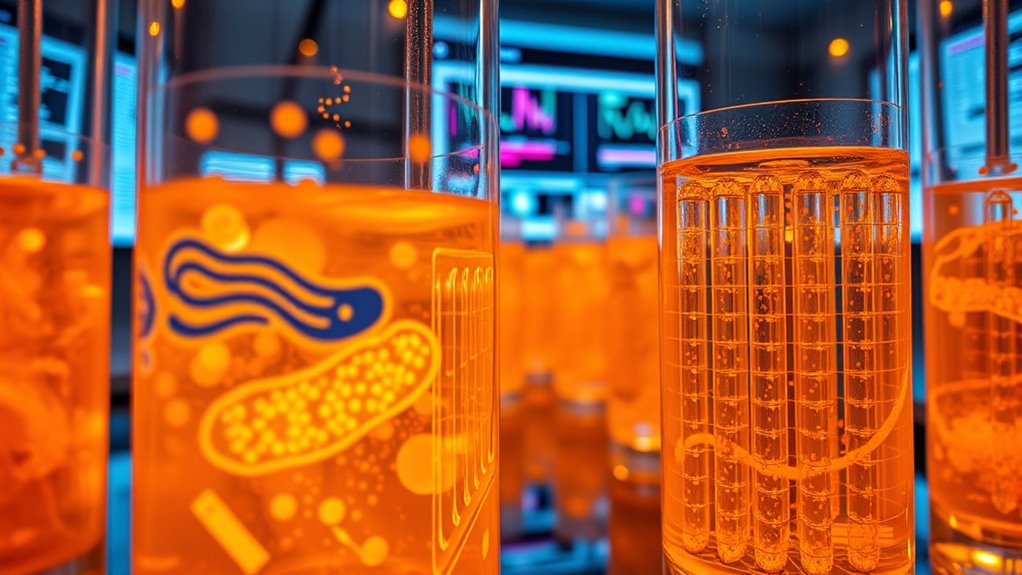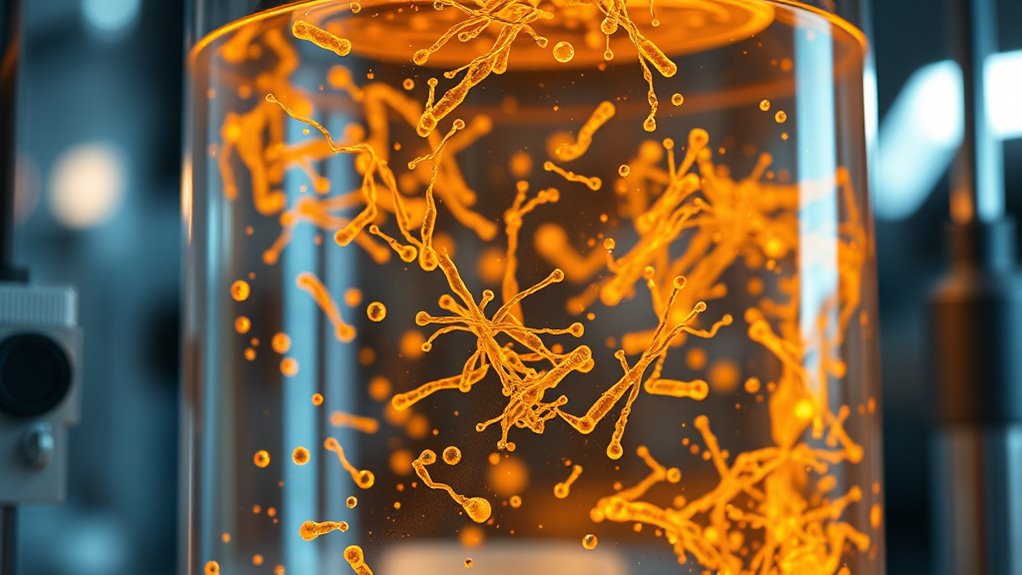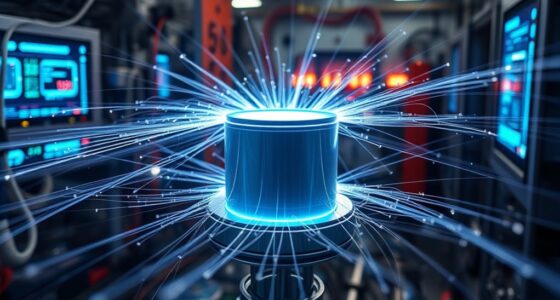Synthetic biology now enables you to engineer bacteria as efficient biofactories that produce jet fuel. By designing custom genetic circuits, you can control bacterial metabolism to shift resources toward hydrocarbons similar to traditional fuels. This approach boosts yield, reduces by-products, and makes large-scale production feasible. The process offers a sustainable alternative to fossil fuels, helping lower carbon emissions. If you keep exploring, you’ll discover how these innovations are shaping a greener energy future.
Key Takeaways
- Synthetic biology enables designing genetic circuits that control bacteria to produce jet fuel precursors efficiently.
- Engineered bacteria can reroute metabolic pathways to synthesize hydrocarbons similar to conventional jet fuels.
- Programmable genetic circuits allow precise regulation of fuel production timing and output levels.
- Bacterial biofactories offer scalable, sustainable alternatives to fossil fuel-based jet fuels.
- This innovation advances environmentally friendly energy solutions by reducing carbon emissions through bio-based fuel synthesis.

Synthetic biology has recently taken a bold step forward with a groundbreaking technique that promises to revolutionize how we engineer living systems. This advancement involves designing and implementing complex genetic circuits within bacteria, allowing you to command these microorganisms to produce specific compounds, such as jet fuel. By integrating carefully crafted genetic circuits, you can control the bacterial metabolic pathways with precision, turning simple microbes into tiny biofactories capable of generating high-value products. This approach not only enhances efficiency but also opens new avenues for sustainable fuel production, reducing reliance on fossil fuels and lowering carbon emissions.
Synthetic biology enables precise control of bacteria to produce sustainable biofuels and high-value compounds.
When you engineer bacteria for jet fuel synthesis, you start by mapping out their natural metabolic pathways. These pathways are like a series of interconnected chemical reactions that sustain the bacteria’s growth and survival. To produce jet fuel, you need to modify these pathways so that they divert resources toward creating hydrocarbons similar to those found in conventional fuels. By inserting synthetic genetic circuits into the bacterial genome, you can precisely regulate which enzymes are expressed and when. This level of control ensures the bacteria efficiently channel their metabolic energy into fuel production without compromising their growth or viability.
Creating effective genetic circuits involves designing DNA sequences that function as switches, sensors, or regulators within the bacterial cells. You can program these circuits to respond to environmental signals or to optimize production during specific growth phases. For example, you might set up a circuit that activates fuel synthesis only after the bacteria have reached a certain density, maximizing output while minimizing metabolic stress. This fine-tuning allows for a more predictable and scalable process, making industrial biofuel production more feasible and cost-effective.
Furthermore, by manipulating metabolic pathways through synthetic biology, you can enhance the yield and purity of the jet fuel components. The bacteria can be engineered to produce hydrocarbons with specific chain lengths and structures, mimicking traditional fossil fuels but with a biological origin. These tailored pathways reduce by-products and simplify downstream processing, further improving the overall efficiency of biofuel manufacturing. As you refine these genetic circuits and metabolic routes, the potential for sustainable, renewable jet fuel becomes increasingly practical and economically viable.
In essence, this innovative approach leverages the power of genetic circuits and metabolic pathway engineering, transforming bacteria into versatile biofactories. It’s a game-changer for clean energy, offering a promising alternative to conventional fuels and paving the way for a greener, more sustainable future.
Frequently Asked Questions
What Are the Environmental Impacts of Engineered Bacteria Producing Jet Fuel?
You might wonder about the environmental impacts of engineered bacteria producing jet fuel. While this innovation can reduce reliance on fossil fuels, it could affect bacterial biodiversity and ecological balance. Introducing modified bacteria into environments might disrupt native microbial communities, potentially harming ecosystems. You should consider how these changes could lead to unintended consequences, emphasizing the importance of careful assessment before widespread application to protect ecological integrity.
How Cost-Effective Is Bacterial Jet Fuel Compared to Traditional Methods?
Imagine a future where sleek jets soar on bacteria-crafted fuel, cutting costs and emissions. You’ll find that bacterial jet fuel’s cost analysis shows promising potential, mainly due to lower feedstock expenses and scalable production. While still in development, its economic viability improves as technology advances and production costs decrease. Compared to traditional methods, it promises a more sustainable, cost-effective alternative, making the dream of eco-friendly aviation more attainable for you.
Are There Safety Concerns With Releasing Engineered Bacteria Into the Environment?
You should consider biosafety concerns and ecological risks when releasing engineered bacteria into the environment. These bacteria could potentially transfer genes to native microbes, disrupting ecosystems or creating resistant strains. While advancements help mitigate these risks, strict regulations and containment strategies remain essential. You need to stay informed about ongoing research and safety protocols to make certain that environmental release is safe and responsible, minimizing any unintended ecological impacts.
Can This Technology Be Scaled for Commercial Jet Fuel Production?
Think of this technology as a seed that could grow into a forest. You might wonder if it can be scaled for commercial jet fuel production. The answer depends on overcoming scalability challenges and ensuring economic feasibility. While promising, developing large-scale processes requires refining bacteria efficiency and reducing costs. If these hurdles are managed, this innovation could transform the industry, making sustainable jet fuel a practical reality for widespread use.
What Regulatory Approvals Are Needed for Bacteria-Based Fuel Manufacturing?
You’ll need to navigate biosafety regulations to guarantee your bacteria-based fuel manufacturing is safe and compliant with local and international standards. Additionally, securing intellectual property rights is vital to protect your innovations and prevent unauthorized use. Regulatory approvals typically involve environmental impact assessments, safety testing, and patent filings, depending on your jurisdiction. Staying informed about evolving policies helps you meet legal requirements and smoothly bring your biofuel to market.
Conclusion
Imagine you’re steering a ship through uncharted waters, and synthetic biology becomes your guiding compass. With scientists engineering bacteria to produce jet fuel, you’re witnessing a revolution that could cut emissions by up to 90%. Just like a pilot adjusting their course, these innovations steer us toward a cleaner, sustainable future. This breakthrough isn’t just science fiction—it’s a real-world map pointing us to greener skies and a healthier planet.










